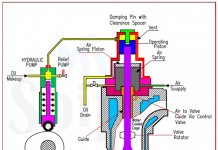
For the scavenge fire to begin there must be present a combustible material, oxygen to support the combustion process, & a source of heat at a temperature high enough to start the combustion. In the case of the scavenge fires the combustible material is oil. The oil can be the cylinder oil which has drained down from the cylinder spaces, or the crankcase oil carried upwards on the piston rod because of the damaged stuffing box. In some cases the cylinder oil residues may also contain fuel oil. The fuel may come from the defective injectors, injectors with incorrect pressure setting, fuel particles striking the cylinders & other similar causes. The oxygen required for the combustion comes from the scavenge air which is in plentiful supply for the operation of the engines. The source of the heat for the ignition comes from the piston blowby, slow ignition & afterburning, or excessive exhaust back pressure, which causes a blowback through the scavenge ports.
INDICATIONS
Indications of a scavenge fire are loss in the power & irregular running of the engine, high exhaust temperatures of the corresponding units, high local temperature in the scavenge trunk, surging of the turbocharger, & sparks & smoke liberated. from the scavenge drains. External indications will be given by a smoky exhaust & the discharge of the sooty smuts or the carbon particles. If the scavenge trunk is oily the fire may spread back from the space around or adjacent to the cylinders where the fire started & will show itself as a very hot spots or areas of the scavenge trunk surfaces. In ships where the engine room is designed as UMS, temperature sensors are installed at critical points within the scavenge spaces. activation would cause automatic slow down of the engine.
ACTION
If a scavenge fire starts two immediate objectives arise- they are to contain the fire within the scavenge space of the engine & to prevent or minimize damage to the engine. The engine must be put to dead slow ahead & the fuel must be taken off the cylinders affected by the fire. The lubrication to these cylinders must be increased to prevent seizure & all scavenge drains must be shut to restrict the discharge of the sparks & burning oil from the drains into the engine room. A minor fire may shortly burn out without damage, & conditions will gradually return to the normal. The affected units should be run on reduced power till inspection of the scavenge trunking & overhaul of the cylinder & piston can be carried out at the earliest safe opportunity. Once navigational circumstances allow it, the engine should be stopped & the whole of the scavenge trunk examined & any oil residues found round other cylinders removed. The real cause of the initiation of the fire should be investigated.
If the scavenge fire is of a more major nature, if there is a risk of the fire extending or if the scavenge trunk is adjacent to the crankcase with risk of a hot spot developing it sometimes becomes necessary to stop the engine. Normal cooling is maintained, & the turning gear engaged & operated. Fire extinguishing medium should be applied through fittings in the scavenge trunk: these may inject carbon dioxide, dry powder or smothering steam. The fire is then extinguished before it can spread to surfaces of the scavenge trunk where it may cause the paint to start burning if special non inflammable paint has not been used. Boundary cooling of the scavenge trunk may be necessary. Keep clear of scavenge relief valves, and do not open up for inspection until the engine has cooled down.
After extinguishing the fire & cooling down, the scavenge trunking & scavenge ports should be cleaned & the trunking together with the cylinder liner & water seals, piston, piston rings, piston skirt, piston rod & gland must be inspected. Heat causes distortion & therefore checks for the binding of piston rod in stuffing box & piston in liner must be carried out. Tightness of the tie bolts should be checked before restarting the engine. Inspect reed valves if fitted, & scavenge relief valve springs. Fire extinguishers should be recharged at the first opportunity & faults diagnosed as having caused the fire must be rectified.
PREVENTION
To avoid the scavenge fires good maintenance & correct adjustment must be carried out. Scavenge trunking must be periodically inspected & cleaned & any buildup of the contamination noted & remedied. The drain pockets should also be cleaned regularly to remove the thicker carbonized oil sludges which do not drain down so easily & which are a common cause of the choked drain pipes. Scavenge drains should be blown regularly & any passage of oil from them noted.
The piston rings must be properly maintained & lubricated suitably so that ring blow-by is avoided. At the same time one must guard against excess cylinder oil usage. With timed cylinder oil injection the timing should be periodically checked. Scavenge ports must be kept cleared.
The piston-rod packing rings & scraper rings should also be regularly adjusted so that oil is prevented from entering the scavenge space because of the butted ring segments. This may & does occur irrespective of the positive pressure difference between the scavenge trunk & the crankcase space.
Fuel injection equipment must be kept in good condition, timed correctly, & the mean indicated pressure in each cylinder should also be carefully balanced so that individual cylinders are not overloaded.
If cylinder liner wear is up to maximum limits the possibility of the scavenge fires will not be materially reduced till the liners are renewed.



